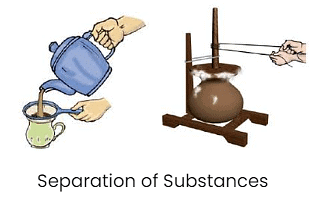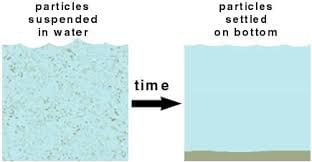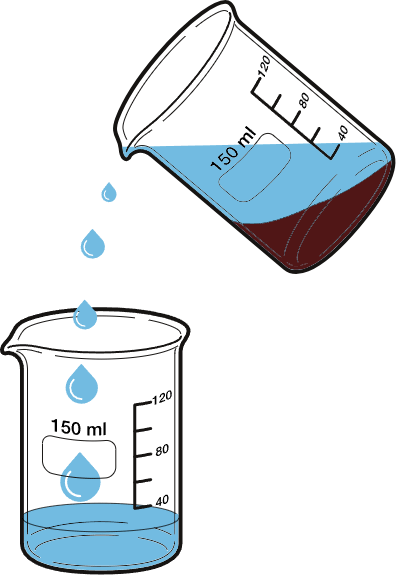Class 6 Exam > Class 6 Notes > Class 6 All Subjects (Old NCERT) > NCERT Summary: Separation of Substances
NCERT Summary: Separation of Substances | Class 6 All Subjects (Old NCERT) PDF Download
What is Separation?
- The removal of substances from a mixture of two or more substances is known as separation.
- Some examples of separation are:
(i) Separating stones from rice
(ii) Churning milk to obtain butter

Why do we need to separate substances?
- To obtain two different components
- To remove impurities or harmful components
- To group substances of different sizes
Methods of Separation
Mixtures of solid with solid 
(i) Hand picking
- Handpicking is a method used to manually remove larger impurities like stones, husks, or dirt from food grains such as wheat, rice, or pulses.
- It is a simple and effective way to separate unwanted items when the quantity of impurities is small.
 Handpicking
Handpicking
(ii) Threshing
- The process in which the stalks are beaten to free the grain seeds.
- Threshing is done with the help of bullocks. For large quantities of grains, machines are used for threshing.
- This method is used by the farmers to separate the grains from the stalks after harvesting.
 Threshing
Threshing
(iii) Winnowing
- It is the process which is used to separate heavier and lighter components of a mixture by wind or by blowing air.
- This method is used by farmers to separate lighter husk particles from heavier seeds of grain.

(iv) Sieving
- It is a process in which components of a mixture of different sizes can be separated by a sieve.
- The smaller particles are removed out through the pore of the sieve and the larger particles are left behind.
- This method is used to separate wheat bran (the bigger particles) from flour.
 Seiving
Seiving
Separation of solids that do not dissolve in liquids

(i) Sedimentation
- This process involves allowing the heavier particles in a mixture to settle down at the bottom when water is added.
- For example, dust particles settle at the bottom when rice is washed.
 Sedimentation
Sedimentation
(ii) Decantation
- After sedimentation, decantation is used to carefully pour off the liquid, leaving the settled heavier particles behind.
- This is how we remove dirty water from washed rice.
- This method is used to separate liquids that don’t mix, like oil from water.
 Decantation
Decantation
(iii) Filtration
- The process in which separation of solid from liquid by filter paper or strainer.
- Example: separating mud from water by using filter paper.
 Filteration
Filteration
Question for NCERT Summary: Separation of SubstancesTry yourself:A mixture of sand and water is stirred and left to stand. After some time, the sand settles at the bottom. What is this process called?
View Solution
Mixtures of solids with liquids
 (i) Evaporation
(i) Evaporation
- This process is used to separate a solid dissolved in a liquid.
- Water is heated until it turns into vapor, leaving the solid behind.
- In this process, liquid changes into gaseous form on heating.
(ii) Condensation
- It is the process when water vapour turns into liquid water, usually by cooling down.
- It happens when warm, moist air cools down, causing the vapor to change back into liquid form.
- For example, when steam from boiling water hits a cold surface, it condenses into droplets of water.
Can water dissolve any amount of a substance?
- Saturation Point: Adding more salt to water eventually leads to a point where no more salt can dissolve; the solution is saturated.
- Heating to Dissolve More: Heating a saturated solution allows more salt to dissolve. When cooled, excess salt may settle.
- Different Solubilities: Water dissolves different substances in varying amounts. Each substance has its own saturation limit.
The document NCERT Summary: Separation of Substances | Class 6 All Subjects (Old NCERT) is a part of the Class 6 Course Class 6 All Subjects (Old NCERT).
All you need of Class 6 at this link: Class 6
|
297 videos|1066 docs|204 tests
|
FAQs on NCERT Summary: Separation of Substances - Class 6 All Subjects (Old NCERT)
| 1. What is the process of separation of substances? |  |
Ans. The process of separation of substances involves isolating different components or particles from a mixture so that they can be identified or used individually.
| 2. What are some common methods of separation of substances? |  |
Ans. Some common methods of separation of substances include filtration, evaporation, distillation, sedimentation, decantation, and chromatography.
| 3. How does filtration work in the separation of substances? |  |
Ans. Filtration is a method of separation that involves passing a mixture through a filter to separate solid particles from a liquid. The solid particles are trapped on the filter while the liquid passes through.
| 4. What is the purpose of distillation in the separation of substances? |  |
Ans. Distillation is a method of separation that is used to separate liquids with different boiling points. The mixture is heated, and the component with the lower boiling point evaporates first and is collected as a separate substance.
| 5. How does chromatography help in the separation of substances? |  |
Ans. Chromatography is a method of separation that is used to separate different components of a mixture based on their different affinities for a stationary phase. As the mixture moves through the stationary phase, the components separate and can be identified individually.
Related Searches

















